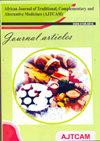MANAGEMENT OF CORONAVIRUS DISEASE 2019 (COVID - 19) – IS THERE A ROLE FOR COMPLEMENTARY AND HERBAL MEDICINAL PRODUCTS?
African Journal of Traditional, Complementary and Alternative Medicines
Pub Date : 2020-05-18
DOI:10.21010/ajtcam.v17i1.4
引用次数: 3
Abstract
Coronaviruses (CoVs) constitute a large family of enveloped positive sense single-stranded RNA viruses, which, due to spiky projections on their surfaces, have crown-like appearance when viewed under the electron microscope. They are divided into four genera, namely, alpha-, beta-, gamma-, and delta-coronaviruses. These viruses, in general, can infect different types of animals as well as humans causing respiratory, gastrointestinal, and nervous system diseases (Huang et al, 2020). Prior to the recent CoV disease outbreak, six species of the viruses that infect humans were known, prominent among which are Severe Acute Respiratory Syndrome-CoV (SARS-CoV) and Middle East Respiratory Syndrome-CoV (MERS-CoV). The other four species (229E, HKU1, OC43, NL63 ) usually cause common cold symptoms (Rothana and Byrared, 2020). Thus, they are pathogens with the human respiratory system as their primary target. Coronaviruses have peculiarity in the sense that they have large genetic diversity and their genomes frequently undergo recombination or mutation. These characteristics result in the periodic emergence of new strains of the virus that have different virulence characteristics. In December 2019, the appearance of a novel coronavirus was reported in Wuhan, Hubei Province of China. This new CoV, just like the earlier known SARS-CoV and MERS-CoV, is zoonotic and belongs to the genus beta-coronavirus. It was identified and called severe acute respiratory syndrome coronavirus -2 (SARS-CoV-2), and also named Coronavirus Disease 2019 (abbreviated COVID19) by World Health Organization (WHO). The symptoms in patients with SARS-CoV-2 include fever, cough, fatigue, dyspnea, runny nose, other upper respiratory symptoms and pneumonia, and these symptoms manifest after an incubation period which ranges from 2 to 14 days. The disease is asymptomatic in many people, mild to moderate in most cases, while it may be severe in the elderly and those with comorbidities resulting in severe pneumonia, acute respiratory distress syndrome (ARDS) and multi-organ dysfunction. The virus is more contagious and spreads faster than its predecessors (SARS-CoA and MERS-CoA) and its fatality rate has been estimated to range from 2 to 5% (Huang et al, 2020; Rothan and Byrared, 2020).2019年冠状病毒病(covid - 19)的管理——补充和草药产品是否有作用?
冠状病毒(cov)是包膜阳性单链RNA病毒的一个大家族,由于其表面有尖刺状突起,在电子显微镜下观察时呈冠状外观。它们分为四属,即α -冠状病毒、β -冠状病毒、γ -冠状病毒和δ冠状病毒。一般来说,这些病毒可以感染不同类型的动物和人类,引起呼吸道、胃肠道和神经系统疾病(Huang et al ., 2020)。在最近的冠状病毒疾病暴发之前,已知六种感染人类的病毒,其中主要是严重急性呼吸综合征-冠状病毒(SARS-CoV)和中东呼吸综合征-冠状病毒(MERS-CoV)。其他四种(229E、HKU1、OC43、NL63)通常会引起普通感冒症状(Rothana和Byrared, 2020)。因此,它们是以人类呼吸系统为主要目标的病原体。冠状病毒具有独特性,因为它们具有很大的遗传多样性,它们的基因组经常发生重组或突变。这些特征导致具有不同毒力特征的病毒新毒株的周期性出现。2019年12月,中国湖北省武汉市报告出现了一种新型冠状病毒。与早期已知的SARS-CoV和MERS-CoV一样,这种新型冠状病毒是人畜共患的,属于β -冠状病毒属。世界卫生组织将其确定为冠状病毒-2 (SARS-CoV-2),并将其命名为冠状病毒病2019(简称covid - 19)。SARS-CoV-2患者的症状包括发烧、咳嗽、疲劳、呼吸困难、流鼻涕、其他上呼吸道症状和肺炎,这些症状在2至14天的潜伏期后出现。该病在许多人中无症状,在大多数情况下为轻度至中度,而在老年人和伴有严重肺炎、急性呼吸窘迫综合征(ARDS)和多器官功能障碍的合并症患者中,该病可能是严重的。该病毒比其前身(SARS-CoA和MERS-CoA)更具传染性,传播速度更快,其致死率估计在2%至5%之间(Huang等人,2020;Rothan and Byrared, 2020)。
本文章由计算机程序翻译,如有差异,请以英文原文为准。
求助全文
约1分钟内获得全文
求助全文
来源期刊
自引率
0.00%
发文量
0
审稿时长
6-12 weeks
期刊介绍:
The “African Journal of Traditional, Complementary and Alternative Medicines (AJTCAM)” is a peer-reviewed, multidisciplinary, international, scientific Open Access Journal that provides publication of articles on phytomedicines, ethnomedicines and veterinary ethnomedicines. The journal is published by a Non-Governmental Organization (NGO) known as “African Traditional Herbal Medicine Supporters Initiative (ATHMSI)”. The Journal welcomes submission of manuscripts that meet the general criteria of significance and scientific excellence. Papers will be published approximately two-to-three months after acceptance

 求助内容:
求助内容: 应助结果提醒方式:
应助结果提醒方式:


